[English] 日本語
 Yorodumi
Yorodumi- EMDB-20498: Cryo-EM Structure of Thermo-Sensitive TRP Channel TRP1 from the A... -
+ Open data
Open data
- Basic information
Basic information
| Entry | Database: EMDB / ID: EMD-20498 | |||||||||
|---|---|---|---|---|---|---|---|---|---|---|
| Title | Cryo-EM Structure of Thermo-Sensitive TRP Channel TRP1 from the Alga Chlamydomonas reinhardtii in Detergent | |||||||||
 Map data Map data | Thermo-Sensitive TRP Channel TRP1 from the Alga Chlamydomonas reinhardtii in detergent | |||||||||
 Sample Sample |
| |||||||||
 Keywords Keywords | Ion Channels / Membrane Protein / TRP Channels / TRANSPORT PROTEIN | |||||||||
| Function / homology |  Function and homology information Function and homology informationstore-operated calcium channel activity / inositol 1,4,5 trisphosphate binding / cation channel complex / regulation of cytosolic calcium ion concentration / calcium ion transmembrane transport / plasma membrane Similarity search - Function | |||||||||
| Biological species |  | |||||||||
| Method | single particle reconstruction / cryo EM / Resolution: 3.53 Å | |||||||||
 Authors Authors | McGoldrick LL / Singh AK | |||||||||
| Funding support |  United States, 1 items United States, 1 items
| |||||||||
 Citation Citation |  Journal: Nat Commun / Year: 2019 Journal: Nat Commun / Year: 2019Title: Structure of the thermo-sensitive TRP channel TRP1 from the alga Chlamydomonas reinhardtii. Authors: Luke L McGoldrick / Appu K Singh / Lusine Demirkhanyan / Ting-Yu Lin / Ryan G Casner / Eleonora Zakharian / Alexander I Sobolevsky /  Abstract: Algae produce the largest amount of oxygen on earth and are invaluable for human nutrition and biomedicine, as well as for the chemical industry, energy production and agriculture. The mechanisms by ...Algae produce the largest amount of oxygen on earth and are invaluable for human nutrition and biomedicine, as well as for the chemical industry, energy production and agriculture. The mechanisms by which algae can detect and respond to changes in their environments can rely on membrane receptors, including TRP ion channels. Here we present a 3.5-Å resolution cryo-EM structure of the transient receptor potential (TRP) channel crTRP1 from the alga Chlamydomonas reinhardtii that opens in response to increased temperature and is positively regulated by the membrane lipid PIP. The structure of crTRP1 significantly deviates from the structures of other TRP channels and has a unique 2-fold symmetrical rose-shape architecture with elbow domains and ankyrin repeat domains submerged and dipping into the membrane, respectively. Our study provides a structure of a TRP channel from a micro-organism and a structural framework for better understanding algae biology and TRP channel evolution. | |||||||||
| History |
|
- Structure visualization
Structure visualization
| Movie |
 Movie viewer Movie viewer |
|---|---|
| Structure viewer | EM map:  SurfView SurfView Molmil Molmil Jmol/JSmol Jmol/JSmol |
| Supplemental images |
- Downloads & links
Downloads & links
-EMDB archive
| Map data |  emd_20498.map.gz emd_20498.map.gz | 4.8 MB |  EMDB map data format EMDB map data format | |
|---|---|---|---|---|
| Header (meta data) |  emd-20498-v30.xml emd-20498-v30.xml emd-20498.xml emd-20498.xml | 12.9 KB 12.9 KB | Display Display |  EMDB header EMDB header |
| Images |  emd_20498.png emd_20498.png | 191.2 KB | ||
| Filedesc metadata |  emd-20498.cif.gz emd-20498.cif.gz | 6.2 KB | ||
| Archive directory |  http://ftp.pdbj.org/pub/emdb/structures/EMD-20498 http://ftp.pdbj.org/pub/emdb/structures/EMD-20498 ftp://ftp.pdbj.org/pub/emdb/structures/EMD-20498 ftp://ftp.pdbj.org/pub/emdb/structures/EMD-20498 | HTTPS FTP |
-Validation report
| Summary document |  emd_20498_validation.pdf.gz emd_20498_validation.pdf.gz | 437.2 KB | Display |  EMDB validaton report EMDB validaton report |
|---|---|---|---|---|
| Full document |  emd_20498_full_validation.pdf.gz emd_20498_full_validation.pdf.gz | 436.8 KB | Display | |
| Data in XML |  emd_20498_validation.xml.gz emd_20498_validation.xml.gz | 5.7 KB | Display | |
| Data in CIF |  emd_20498_validation.cif.gz emd_20498_validation.cif.gz | 6.5 KB | Display | |
| Arichive directory |  https://ftp.pdbj.org/pub/emdb/validation_reports/EMD-20498 https://ftp.pdbj.org/pub/emdb/validation_reports/EMD-20498 ftp://ftp.pdbj.org/pub/emdb/validation_reports/EMD-20498 ftp://ftp.pdbj.org/pub/emdb/validation_reports/EMD-20498 | HTTPS FTP |
-Related structure data
| Related structure data |  6pw4MC  6pw5C C: citing same article ( M: atomic model generated by this map |
|---|---|
| Similar structure data |
- Links
Links
| EMDB pages |  EMDB (EBI/PDBe) / EMDB (EBI/PDBe) /  EMDataResource EMDataResource |
|---|---|
| Related items in Molecule of the Month |
- Map
Map
| File |  Download / File: emd_20498.map.gz / Format: CCP4 / Size: 30.5 MB / Type: IMAGE STORED AS FLOATING POINT NUMBER (4 BYTES) Download / File: emd_20498.map.gz / Format: CCP4 / Size: 30.5 MB / Type: IMAGE STORED AS FLOATING POINT NUMBER (4 BYTES) | ||||||||||||||||||||||||||||||||||||||||||||||||||||||||||||||||||||
|---|---|---|---|---|---|---|---|---|---|---|---|---|---|---|---|---|---|---|---|---|---|---|---|---|---|---|---|---|---|---|---|---|---|---|---|---|---|---|---|---|---|---|---|---|---|---|---|---|---|---|---|---|---|---|---|---|---|---|---|---|---|---|---|---|---|---|---|---|---|
| Annotation | Thermo-Sensitive TRP Channel TRP1 from the Alga Chlamydomonas reinhardtii in detergent | ||||||||||||||||||||||||||||||||||||||||||||||||||||||||||||||||||||
| Projections & slices | Image control
Images are generated by Spider. | ||||||||||||||||||||||||||||||||||||||||||||||||||||||||||||||||||||
| Voxel size | X=Y=Z: 1.06 Å | ||||||||||||||||||||||||||||||||||||||||||||||||||||||||||||||||||||
| Density |
| ||||||||||||||||||||||||||||||||||||||||||||||||||||||||||||||||||||
| Symmetry | Space group: 1 | ||||||||||||||||||||||||||||||||||||||||||||||||||||||||||||||||||||
| Details | EMDB XML:
CCP4 map header:
| ||||||||||||||||||||||||||||||||||||||||||||||||||||||||||||||||||||
-Supplemental data
- Sample components
Sample components
-Entire : crTRP1 in detergent
| Entire | Name: crTRP1 in detergent |
|---|---|
| Components |
|
-Supramolecule #1: crTRP1 in detergent
| Supramolecule | Name: crTRP1 in detergent / type: complex / ID: 1 / Parent: 0 / Macromolecule list: #1 |
|---|---|
| Source (natural) | Organism:  |
-Macromolecule #1: TRP-like ion channel
| Macromolecule | Name: TRP-like ion channel / type: protein_or_peptide / ID: 1 / Number of copies: 4 / Enantiomer: LEVO |
|---|---|
| Source (natural) | Organism:  |
| Molecular weight | Theoretical: 99.538742 KDa |
| Recombinant expression | Organism:  Homo sapiens (human) Homo sapiens (human) |
| Sequence | String: MKVAPAPASG QPGGGSKKPS DYGCQLHYKH ARVVEPESTT DDGMKRLKDV GDKGTLITAA ELGLVDKYRD LKRAGQDILT CDWPYHYSS ILYACYGNQY KILQMVEREF VGSTQELTAM HTTRCWVGKN SAMVAAYQGH LETMLYIIDL DMQGKFTEDL F KQRDVMGK ...String: MKVAPAPASG QPGGGSKKPS DYGCQLHYKH ARVVEPESTT DDGMKRLKDV GDKGTLITAA ELGLVDKYRD LKRAGQDILT CDWPYHYSS ILYACYGNQY KILQMVEREF VGSTQELTAM HTTRCWVGKN SAMVAAYQGH LETMLYIIDL DMQGKFTEDL F KQRDVMGK NAMMWAASQG HTDTIEVLLV RSLYRLLPED CADPLVLKTR WKLVSLLADL ASHCRDYDPG CSRSFFQEVL AS IKYDPVE GARQEEAAAA GGGGSAREGA ALHEPTWGVD DGEEEERRHG VKHSDLVGKS AASTTAAAAA GGKTASGKPG EPG GGGAVK LKDVHITVRT LQGVIVSAYR AGMNCMGVIM YCQSLLQQAR YFDDLVAQLT AWEVKLLDTC RNKQEVQAIL APTE DDPSE PVGYALATFD KAFLSHKFVQ QIFTEKWDTM GVTDYTKSLF GVVWGGCSLV VAFAAWATIC PLVVVARSFL SPVQD FMMR GKVIVDSRFP WHVPLYRWLL TQCALITFTV LLSYLVFSFD PSDPVPASVA PLNTFLAVWC AAILVDEVQE YVEEGR AEY MSSGWNVMDV TMALSYILHY ILRIIAVRVT DNLNILLVVN DLLAAAALMA WFRMVSVFEL SSAIGPLIQM MKQMLIK DV TRFALLVLVI LLGFSVGMEA LFQEACIERD PTTNECTKYT SWGYDWQKDG LVGGMTFLQY IALGNANPVD FEQKRVTG V IFYLIFAIVT AILLLNLFIA MLADTYTRVS TQAMVEFRYR KAKLMASYSR RDFVCPPFNL LHLVCAAVGN GLRRLVWGP DGFTPVSMRK NETVPLFSWY FPQGEEMRQV VVLQRRVVDD FLNSNRVALF REKLNAELPN LVHEMLKQKG KGDGGALAGG GAAASTTVL ATAVSVTAAA GH UniProtKB: TRP-like ion channel |
-Macromolecule #2: [(2R)-2-octanoyloxy-3-[oxidanyl-[(1R,2R,3S,4R,5R,6S)-2,3,6-tris(o...
| Macromolecule | Name: [(2R)-2-octanoyloxy-3-[oxidanyl-[(1R,2R,3S,4R,5R,6S)-2,3,6-tris(oxidanyl)-4,5-diphosphonooxy-cyclohexyl]oxy-phosphoryl]oxy-propyl] octanoate type: ligand / ID: 2 / Number of copies: 2 / Formula: PIO |
|---|---|
| Molecular weight | Theoretical: 746.566 Da |
| Chemical component information | 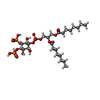 ChemComp-PIO: |
-Macromolecule #3: 1,2-DIOLEOYL-SN-GLYCERO-3-PHOSPHOCHOLINE
| Macromolecule | Name: 1,2-DIOLEOYL-SN-GLYCERO-3-PHOSPHOCHOLINE / type: ligand / ID: 3 / Number of copies: 2 / Formula: PCW |
|---|---|
| Molecular weight | Theoretical: 787.121 Da |
| Chemical component information | 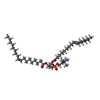 ChemComp-PCW: |
-Macromolecule #4: 1-PALMITOYL-2-LINOLEOYL-SN-GLYCERO-3-PHOSPHOCHOLINE
| Macromolecule | Name: 1-PALMITOYL-2-LINOLEOYL-SN-GLYCERO-3-PHOSPHOCHOLINE / type: ligand / ID: 4 / Number of copies: 2 / Formula: CPL |
|---|---|
| Molecular weight | Theoretical: 758.06 Da |
| Chemical component information | 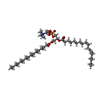 ChemComp-CPL: |
-Macromolecule #5: (2S)-3-{[(R)-hydroxy{[(1R,2R,3S,4R,5R,6S)-2,3,6-trihydroxy-4,5-bi...
| Macromolecule | Name: (2S)-3-{[(R)-hydroxy{[(1R,2R,3S,4R,5R,6S)-2,3,6-trihydroxy-4,5-bis(phosphonooxy)cyclohexyl]oxy}phosphoryl]oxy}propane-1,2-diyl dihexadecanoate type: ligand / ID: 5 / Number of copies: 4 / Formula: PIK |
|---|---|
| Molecular weight | Theoretical: 970.992 Da |
| Chemical component information | 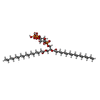 ChemComp-PIK: |
-Experimental details
-Structure determination
| Method | cryo EM |
|---|---|
 Processing Processing | single particle reconstruction |
| Aggregation state | particle |
- Sample preparation
Sample preparation
| Concentration | 2 mg/mL |
|---|---|
| Buffer | pH: 8 Details: 150 mM NaCl, 20 mM Tris-HCl pH 8.0, 1 mM BME and 0.01% GDN |
| Grid | Support film - Material: CARBON / Support film - topology: HOLEY / Details: unspecified |
| Vitrification | Cryogen name: ETHANE / Chamber humidity: 100 % / Chamber temperature: 277 K / Instrument: FEI VITROBOT MARK IV |
- Electron microscopy
Electron microscopy
| Microscope | FEI TITAN KRIOS |
|---|---|
| Image recording | Film or detector model: GATAN K2 SUMMIT (4k x 4k) / Detector mode: COUNTING / Average electron dose: 61.0 e/Å2 |
| Electron beam | Acceleration voltage: 300 kV / Electron source:  FIELD EMISSION GUN FIELD EMISSION GUN |
| Electron optics | Illumination mode: FLOOD BEAM / Imaging mode: BRIGHT FIELD |
| Experimental equipment |  Model: Titan Krios / Image courtesy: FEI Company |
- Image processing
Image processing
| Startup model | Type of model: NONE |
|---|---|
| Final reconstruction | Applied symmetry - Point group: C2 (2 fold cyclic) / Resolution.type: BY AUTHOR / Resolution: 3.53 Å / Resolution method: FSC 0.143 CUT-OFF / Number images used: 63018 |
| Initial angle assignment | Type: PROJECTION MATCHING |
| Final angle assignment | Type: PROJECTION MATCHING |
-Atomic model buiding 1
| Refinement | Space: REAL / Protocol: FLEXIBLE FIT |
|---|---|
| Output model |  PDB-6pw4: |
 Movie
Movie Controller
Controller


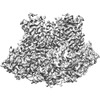
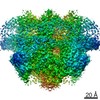

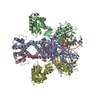
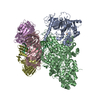

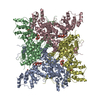


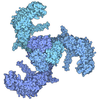
 Z (Sec.)
Z (Sec.) Y (Row.)
Y (Row.) X (Col.)
X (Col.)





















